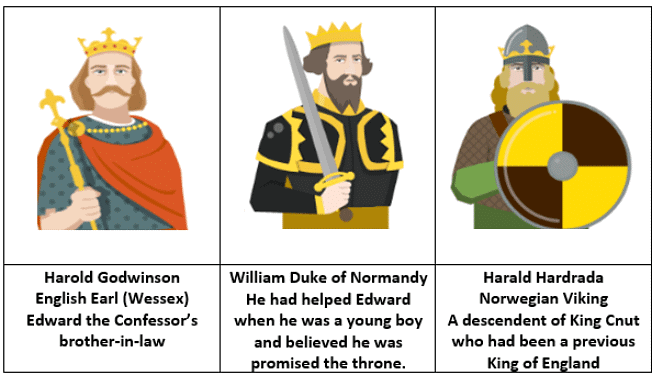Year 7 Exam > Year 7 Notes > Claimants to the throne in 1066
Claimants to the throne in 1066 - Year 7 PDF Download
| Table of contents |

|
| Introduction |

|
| Edward the Confessor |

|
| Claimants to the throne |

|
| Who was crowned king? |

|
| The Battle of Stamford Bridge |

|
Introduction
- 1066 is a significant year in English history, marked by the demise of two monarchs, two invasions, and enduring repercussions.
- The passing of Edward the Confessor in January 1066 initiated a period of unrest.
- Four prominent claimants vied for the English throne, each possessing strong assertions to kingship.
Edward the Confessor
- Edward the Confessor was the King of England from 1042 until his death in 1066. When he died, there was uncertainty about his successor due to his lack of a direct heir.
- In typical circumstances, the line of succession to the throne is clear, but Edgar the Atheling, Edward's great-nephew and closest living heir, was only 14 years old at that time.
- Edgar was deemed too young and inexperienced to handle the responsibilities of kingship and the wars that were anticipated from rival claimants to the throne.
- The line of succession refers to the order of people in line to become the next monarch.
- Three main contenders vied for the English throne after Edward's death: Harold Godwinson, Harald Hardrada, and William of Normandy.
- Harold Godwinson became King of England in 1066 but was later defeated and killed in the Battle of Hastings.
- Harald Hardrada, a Viking leader, claimed to be the rightful heir but was defeated at the Battle of Stamford Bridge.
- William of Normandy, also known as William the Conqueror, invaded England and won the throne at the Battle of Hastings.
Question for Claimants to the throne in 1066Try yourself: Who became the King of England in 1066 after the death of Edward the Confessor?View Solution
Claimants to the throne

Harold Godwinson
- Harold Godwinson hailed from Wessex, England, as a prosperous nobleman. According to accounts, Edward the Confessor supposedly designated Godwinson as his heir on his deathbed.
- Being the brother-in-law of the king due to his sister Edith's marriage to Edward, Godwinson's claim was well-supported by a significant portion of the English populace.
William of Normandy
- William, a Duke controlling Normandy in northern France, asserted a distant kinship with Edward the Confessor, alleging that Edward had pledged him the throne in 1051.
- William claimed that Harold Godwinson had sworn an oath to assist him in seizing the throne post-Edward, in exchange for previous aid when Godwinson was stranded in Normandy in 1064.
Harald Hardrada
- Harald Hardrada, a Viking and the Norwegian king, maintained a connection to King Cnut, a former English monarch during Viking invasions.
- Enjoying the backing of Tostig, Harold Godwinson's sibling, Harald Hardrada's claim was bolstered. The siblings had a falling-out, leading to Tostig's removal as the Earl of Northumbria due to his unpopular rule.
Claimants to the throne activity
- Before the year 1066, there were descendants of Viking invaders in northern England who supported Harald Hardrada's claim to the throne.
Who was crowned king?
- Following Edward the Confessor's death on 6 January 1066, the Witan, a council of English nobility tasked with advising the king, convened to decide the next monarch.
- Harold Godwinson was chosen by the Witan to be crowned king on the same day as Edward's death.
- William of Normandy and Harald Hardrada, who were contenders for the throne, were discontent with this decision and resolved to seize power through invasion.
- This discontent ultimately led to significant battles, notably the Battle of Stamford Bridge and the decisive Battle of Hastings.
The Battle of Stamford Bridge
- In September 1066, Harald Hardrada and 8000 Viking warriors invaded northern England, moving towards York and gathering additional supporters from Scotland and northern England.
- Expecting an invasion from William of France, Harold Godwinson, the new king, swiftly led his army 185 miles north in just four days to confront Harald Hardrada's forces, catching them off guard.
- The confrontation culminated in the Battle of Stamford Bridge near York, where a Viking warrior obstructed the bridge, hindering Harold's army. To overcome this obstacle, an English soldier floated under the bridge in a barrel, surprising the Viking and enabling the English army to cross the river.
- The Anglo-Saxon Chronicle, a historical record from the time of King Alfred the Great, recounts this event and provides insights into life in Anglo-Saxon England.
- Following a fierce battle, Harold Godwinson emerged victorious, resulting in the deaths of Hardrada and Tostig. The surviving members of Hardrada's army were permitted to return to Norway.
Question for Claimants to the throne in 1066Try yourself: Who was chosen by the Witan to be crowned king after the death of Edward the Confessor?View Solution
Related Searches



















